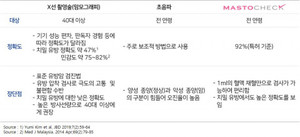
Proteomics (Proteomics)-based early diagnosis technology development company Bertis (CEO, Han Syngman) emphasizes the importance of prevention and early detection of breast cancer, which has recently ranked first in the world on’Cancer Prevention Day’ on March 21st. did.
According to a foreign paper published earlier this year in the Journal of Cancer for Clinicians, about 19.3 million cancer patients occurred worldwide in 2020, and 10 million died of cancer. The most commonly diagnosed cancers were △ breast cancer △ lung cancer △ colorectal cancer △ prostate cancer △ gastric cancer. In particular, breast cancer occurs in most women, but it is 11.7% of all cancer cases, surpassing lung cancer (11.4%), which has remained the No. 1 position for the past 20 years, to a new No. 1 position, signaling the beginning of a change in the cancer environment. Accordingly, there is a need for more active breast cancer prevention and breast health management in Korea.
◇It is important to prevent stage progression through early diagnosis of breast cancer.
As of 2018, there were 23,000 new cases of breast cancer patients in Korea per year, and the number of breast cancer patients in Korea increased sharply by about twice over 10 years. The causes of breast cancer incidence have not been accurately identified, but it is estimated that the total duration of estrogen exposure increased due to early menarche, late menopause, late marriage and lower fertility rates, and obesity due to westernized diets of high fat and high calories.
Breast cancer is characterized by no symptoms in the early stages. As the disease progresses, the most common symptom is a painless lump, which can be felt not only in the breasts, but also in the armpits. If the cancer progresses severely, the skin of the breast is pulled into the inside and dents or the nipples are depressed, and as it progresses further, the enlarged cancer lump almost destroys the shape of the breast. In this case, mastectomy is inevitable, so in order to prevent mastectomy and improve the quality of life through appropriate treatment, it is essential to detect it as early as possible.
Professor Moon Hyung-gon of Surgery at Seoul National University Hospital said, “If breast cancer is detected early, the treatment results are positive and the survival rate is higher than other cancers.” “The actual 5-year breast cancer survival rate is 90 in patients with stage 0, 1, and 2 who are classified as early breast cancer. The survival rate is higher than %, but in stage 4 patients with systemic metastasis, the survival rate is as low as 34%. Therefore, it is most important to detect and treat quickly through early diagnosis and prevent the progression of the stage.”
◇There is a need to expand breast cancer diagnosis options
Methods of diagnosing breast cancer include self-examination, clinical examination, and imaging tests (breastography, breast ultrasound). In the current country, in order to detect breast cancer early and reduce mortality, it is recommended that asymptomatic women aged 40 to 69 undergo breast cancer screening every two years using mammography (mammography) △Asymptomatic women aged 70 or older are determined after consulting a clinician. Is presented as a recommendation for examination.
However, considering that mammography, in which radiation exposure is inevitable in young women or women of childbearing age, is not recommended, and breast ultrasound is also a screening method with low evidence of recommendation in the National Cancer Screening Guidelines, a diagnosis that can be selected by women of various ages who require breast cancer screening There is a limitation in that the options are narrow. In particular, in the case of mammography and breast ultrasound, the accuracy may vary depending on the device performance or the reader, and in the case of dense breasts with small breasts and developed mammary tissues, the majority of Korean women, it is difficult to identify cancer lesions, so there is a need for more accurate diagnosis options. This is emerging.
◇The era of breast cancer screening with a single drop of blood opens up
Among these, recently, a technology that can diagnose breast cancer with a single drop of blood has been introduced and is attracting attention. Bertis’ early breast cancer diagnosis technology’Masto Check’ diagnoses early breast cancer with an accuracy of 92% (patent standard) with only a small amount of blood. It quantitatively measures three biomarkers that are closely related to breast cancer in the blood, and then determines whether or not breast cancer is breast cancer by substituting those numbers into a proprietary algorithm.
In particular, Mastocheck can effectively complement existing diagnostic methods in that it maintains a certain screening accuracy even in the case of dense breasts with low accuracy in conventional mammography, there is no risk of exposure to radiation, and it is very easy to diagnose breast cancer using blood. It is attracting attention as a technology that exists. Currently, you can receive examinations through Masto Check at major examination centers such as Hanaro Medical Foundation and Hanshin Medipia.
Seungman Han, CEO of Bertis, said, “Mastocheck is a breast cancer screening that has strengths in many aspects, such as accuracy, safety, and convenience, even for those who are concerned about the risk of exposure to radiation, or for dense breasts that are difficult to accurately diagnose with the existing screening method. “As the importance of breast health management continues to increase, I hope that many women will be able to effectively prevent and manage breast cancer through simple masto check screening.”
